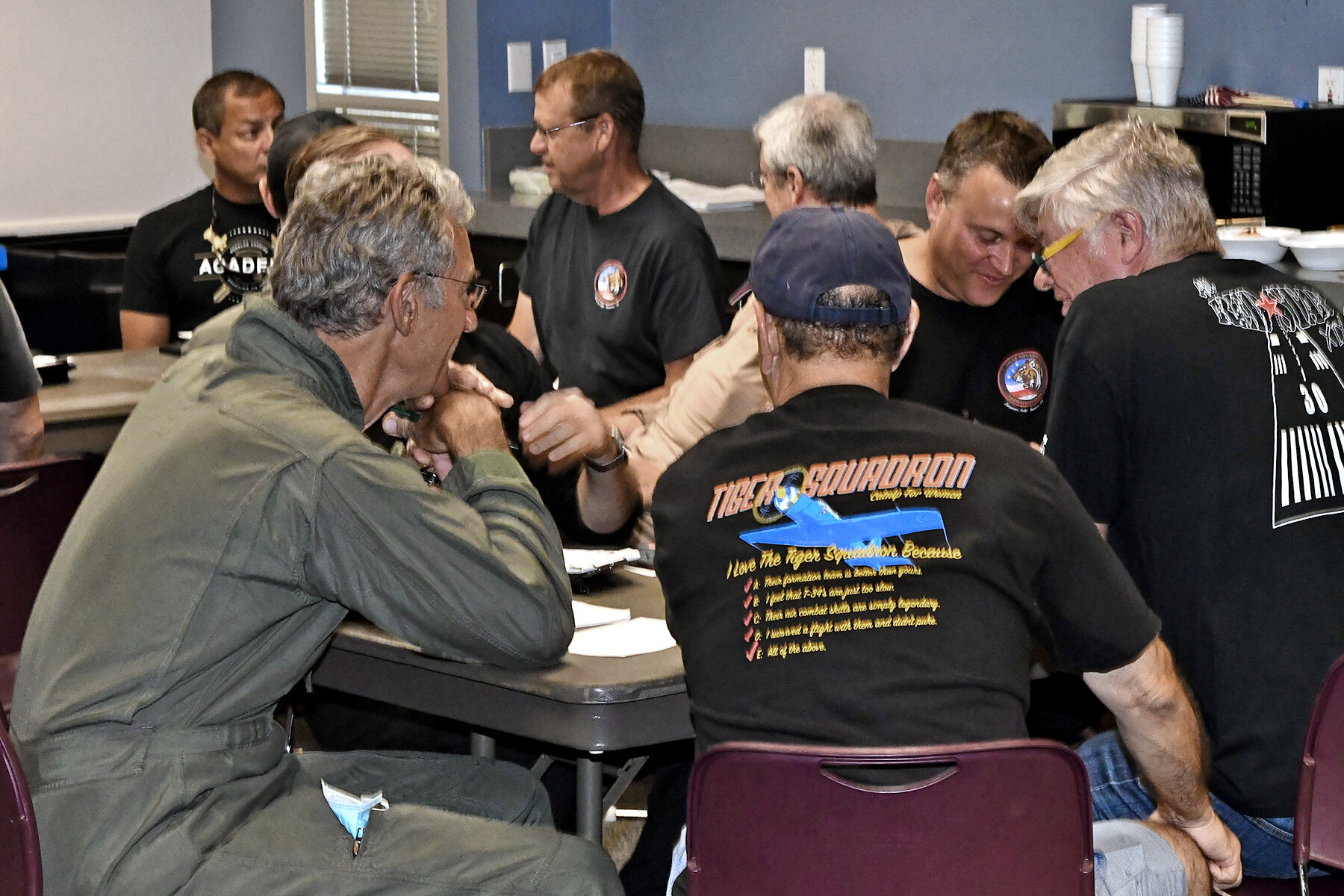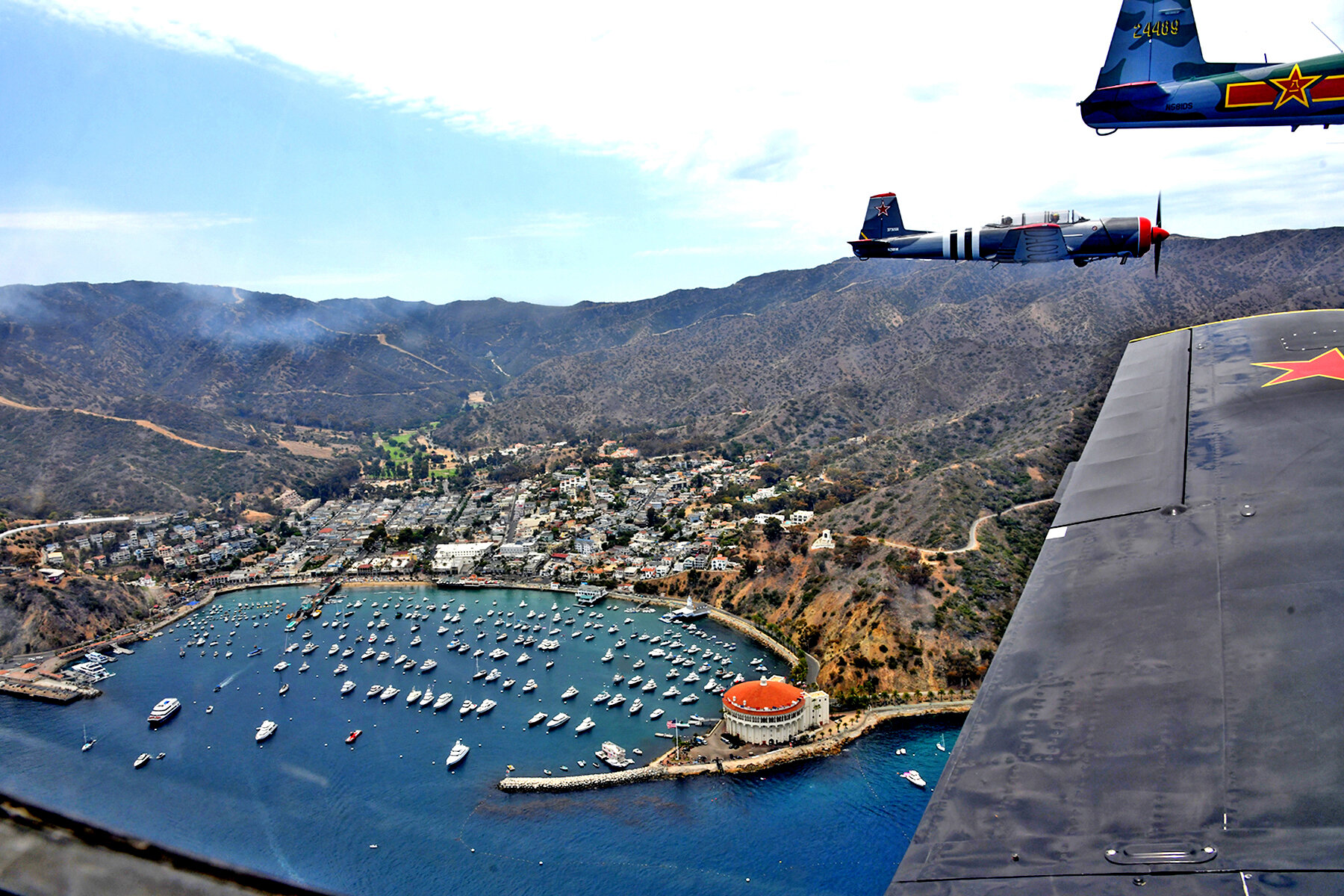Tiger Squadron Hosts Precision Formation Flying Clinic
Tiger Squadron Hosts Precision Formation Flying Clinic
By John Perchulyn
On a recent mid-July weekend, the South Bay skies were filled with about two dozen war birds conducting formation training missions. Members of the Red Star Pilots Association (RPA) and several competition aerobatic pilots were hosted by the Torrance-based Tiger Squadron for a formation flying clinic at Zamperini Field.
The RPA’s mission is to promote and preserve the safe operation, display and enjoyment of all aircraft from the current and former eastern bloc nations. Two such representative aircraft are the Nanchang CJ6A’s and Yak 52s, with the CJ being the most prevalent aircraft type at this formation clinic, which attracted non-local pilots who traveled from Colorado, Arizona and Nevada.
The out-of-town pilots arrived at Zamperini Field on Friday.
Flight training was preceded by a welcome BBQ with an abundance of great food, camaraderie and educational discussions on precision flying maneuvers.
Here are some highlights of the weekend’s activity.
Group Safety Briefing
The formal training commenced Saturday morning with a comprehensive safety briefing conducted by Gil Lipaz, President of the RPA. Gil reviewed the complex FAA-regulated LAX-area airspace, the offshore Palos Verdes Peninsula practice areas that were specifically designated for the simultaneous multi-formation training missions surrounding the airport, as well as formation launch and recovery procedures. Lipaz made it clear that safety was of the utmost importance.
Formation Briefing
Once the safety briefing was completed, the pilots broke up into scheduled flights of four planes consisting of experienced formation pilots in certain planes and instructor pilots (IP) paired with student pilots in others.
The lead pilot conducted the flight briefs. It is ultimately lead’s responsibility to brief every aspect of the flight from radio procedures to flight operations. Lead also ensures that the flight training objectives, weather, sequence of events, communications and emergency procedures are discussed before every formation flight.
Each pilot’s position is assigned as are the in-flight formation changes and maneuvers to be performed. Each four-plan formation consisted of the lead pilot and three wing pilots. The lead pilot will do just that, lead the formation through the execution of maneuvers with the wing pilots maintaining the proper station-keeping position. While this weekend’s training utilized the four-plane as the standard training formation, the Tiger Squadron routinely performs precision formation flying at prominent pubic events with single formations of up to 12 aircraft.
TAXING
Once the briefing is complete, a time and taxiway location is established for rendezvous/marshal at which the aircraft gather and await clearance to the run-up area.
The Takeoff
After each aircraft has conducted engine run-up and all pre-take-off checks have been completed, lead makes a radio call for take-off.
After the control tower clears the flight of four for takeoff, the pilots line up in pairs on the runway. When ready to launch, the lead pilot gives a visual signal of an exaggerated head nod as the brakes are released and the throttles advance.
The pilots head out to the shoreline where they make a left turn to head for the designated practice areas off the Palos Verdes Peninsula. The pilots exercise care in these departures to adhere to the local noise abatement procedures. The Tiger Squadron emphasized to the non-local pilots the importance of being a good neighbor from a noise perspective. For this weekend’s clinic, the RPA had designated five distinct offshore practice areas so that the concurrent formations would not conflict with each other in the traffic area.
Rejoin After Interval Takeoff
Since the four-plane formation takes off two at a time, the number three and four aircraft must join up on the leader using either a turning or a running rejoin. In a turning rejoin, number two rejoins to the inside of the turn and three and four to the outside. For a straight-ahead rejoin, two will rejoin to the left side unless briefed otherwise, with three and four rejoining on the opposite side of two.
Formations
Various formations are flown and practiced; each of which requires coordinated, precise control and movement. These include simple maneuvers such as a cross-under, which allows lead to move aircraft from one side to the other. Other maneuvers include echelon turns, close trail and extended trail.
One of the more fun and dynamic maneuvers is extended trail exercise in which aircraft fly behind one another using lead and lag maneuvers and a constant throttle setting to maintain their position and distance from the plane in front of them.
Element Approach and Landing
The formation element landing permits the efficient recovery of two aircraft simultaneously. Minimum runway width for this maneuver is based on the aircraft’s wingspan.
The Gear Down Call
In the approach to land, the lead pilot will give the appropriate hand signals to his wingman to indicate the coordinated extension of the landing gear and then the flaps.
Debriefing
Just as important as the briefing is the debriefing that takes place after every formation flight. During the debrief, the pilots regroup to discuss the conduct of the flight and answer the following typical questions: Did everybody perform their tasks as they discussed in the briefing? Were the learning objectives met? Were there any irregularities in the formation? Did any safety-of-flight items arise? What lessons learned can be applied to future training missions? Just as with the formation flying itself, all briefs and debriefs are based on the military aviation training standards, which are structured and disciplined.
Training Complete, Catalina for Lunch
Having had a very productive Saturday with dozens of training hours and with some pilots having flown three missions in one day, the group of pilots headed to Catalina Island for a buffalo burger.
The Tiger Squadron and the Red Star Pilots departed Zamperini in two six-ship flights followed by four-ship flight. Upon arriving overhead the city of Avalon, Catalina, the three formations performed a precision fly-over with smoke on for a surprise air show for the residents and visitors.
Image credit: ©2021 DigitalFusion CTI
After landing at the airport and parking, we had a group lunch, discussed the previous day’s events, and took a group photograph to commemorate the clinic and flight training prior to flying back to Zamperini Field or to other home airports.
Bio
John Perchulyn has been a resident of Redondo Beach for 35 years.
Having a love for photography, John opened Riviera Imaging photo lab in 1994 in the Riviera Village. The lab quickly became very well established as the place to go for quality film developing and excellent customer service to the extent that John and his staff won the prestigious National Photofinisher of the Year award in 1996.
Operating the lab for almost 20 years, John elected to retire and sell off the business to Paul’s Photo camera store on Hawthorne Blvd.
While in business, John was very involved in community affairs. Serving two terms on the Redondo Beach Chamber board of directors as well as President of the Riviera Village merchants association.
Most of John’s work consists of “beach photography” capturing the sunsets and beach life in the South Bay. John has had the privilege of having his images grace the cover of the Redondo Beach Visitors Bureau magazine on 3 occasions.
Recently John has joined up with the Tiger Squadron as team photographer to spearhead Public Relations for the Team.



























